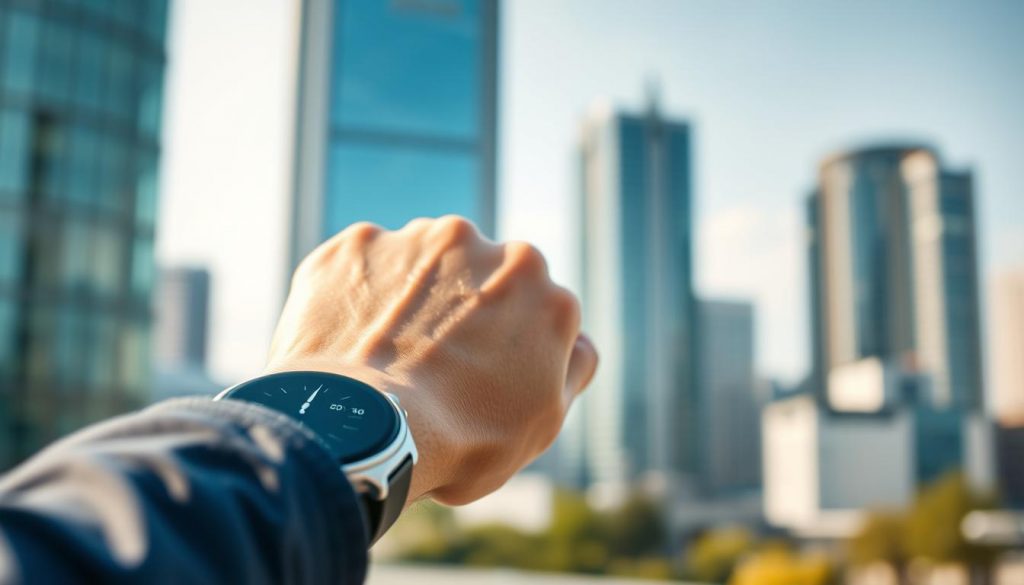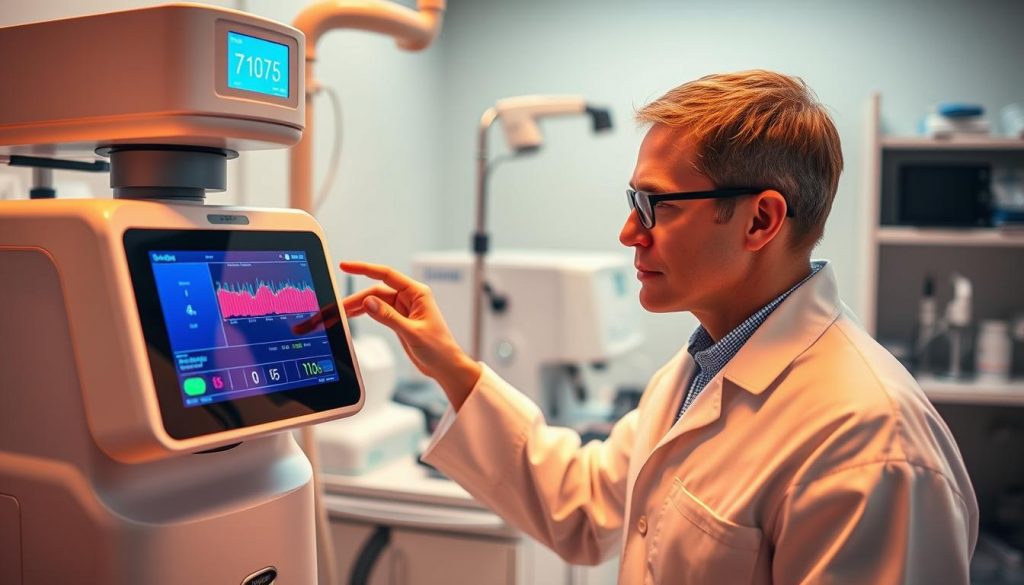Imagine knowing exactly how many fruits and vegetables you’ve consumed today without keeping a food diary. What if your wearable could measure your antioxidant levels in mere seconds?
The latest innovation in wearable health technology makes this possible. A groundbreaking sensor now measures carotenoid levels through a simple thumb scan. This represents a significant leap beyond basic activity monitoring.
This advancement transforms preventative healthcare. Users gain immediate insight into their dietary habits. The feature connects nutritional data with other health metrics, such as sleep patterns and vascular load.
According to research, carotenoid levels reflect consistent intake of fruits and vegetables over time. This technology empowers people to make informed wellness decisions daily.
Key Takeaways
- The device represents a major advancement in wearable health monitoring
- It provides measurable data on antioxidant levels through a simple scan
- Results are available within five seconds of measurement
- The technology offers insights into fruit and vegetable consumption
- It supports a holistic approach to personal wellness management
- This innovation sets new standards for preventative healthcare tools
Introducing the World’s First Wearable Nutrition Tracker
Modern health monitoring leaps forward with instant antioxidant level tracking on your wrist. This innovation transforms how people understand their nutritional status.
The technology represents a significant advancement in personal wellness management. It moves beyond basic activity tracking to provide genuine dietary insights.
Galaxy Watch8’s Groundbreaking Antioxidant Index
The Antioxidant Index quantifies carotenoid levels through skin measurements. These natural pigments accumulate in body tissues over time.
Carotenoids serve as reliable markers for fruit and vegetable consumption. Their presence in the skin reflects long-term dietary patterns rather than short-term changes.
Advanced algorithms process the sensor readings to generate accurate scores. The system accounts for various lifestyle factors that might influence results.
| Score Category | Percentage Range | Dietary Status |
|---|---|---|
| Very Low | Less than 50% | Insufficient intake |
| Low | 50%-100% | Moderate intake |
| Optimal | 100% or more | Adequate intake |
From Science Fiction to Wrist-Worn Reality
Transforming laboratory-grade technology into wearable form required remarkable engineering. The development team miniaturised sophisticated sensor systems into a compact device.
Clinical trials at a major medical centre validated the technology’s accuracy across diverse users. Testing confirmed consistent performance regardless of skin tone variations.
Antioxidants play a crucial role in combating oxidative stress within the body. Experts emphasise their importance for long-term health maintenance.
Dr. Hyojee Joung notes:
“Regular monitoring of antioxidant status provides valuable insights into cellular protection mechanisms. This approach supports preventative healthcare strategies.”
The user experience prioritises simplicity and accessibility. Individuals obtain their antioxidant score within five seconds via a thumb scan.
This feature integrates with broader wellness metrics, including sleep patterns and vascular load. The comprehensive approach offers holistic health insights.
This innovation represents a shift toward proactive personal health management. It makes advanced monitoring accessible without specialised knowledge or equipment.
How Samsung’s Nutrition Tracking Technology Works
The mechanism behind this innovation combines sophisticated engineering with advanced data processing. It transforms complex biological measurements into simple user insights.
The Miniaturised Sensor Breakthrough
Developing this capability required shrinking laboratory-grade technology into a wearable device. Engineers spent seven years perfecting a coin-sized sensor system.
This component uses multi-wavelength LEDs paired with photodetector arrays. It employs reflectance spectroscopy to analyse skin composition.
The system emits light at different wavelengths during each measurement. It then measures how much light gets absorbed versus reflected by skin tissues.
Advanced Algorithm and Calibration Systems
Raw sensor data undergoes sophisticated processing through custom algorithms. These systems perform real-time calibration for each individual user.
The technology accounts for various factors that might affect readings. It adjusts for environmental conditions and personal physiological characteristics.
This personalised approach ensures consistent accuracy over time. Users receive reliable feedback about their dietary patterns.
Discover how Samsung is bridging the gap between science and daily life with its industry-first nutrition tracking technology, coming soon to the Galaxy Watch.
Ensuring Accuracy Across Diverse Users
Major challenges included maintaining precision across different skin tones. The solution involved using the fingertip for scans rather than other areas.
This location minimises melanin interference in darker skin tones. Light pressure application reduces blood flow artifacts during measurements.
Clinical trials at Samsung Medical Center validated these approaches. Hundreds of participants helped refine the technology’s performance.
| Development Phase | Duration | Key Achievement |
|---|---|---|
| Initial Research | 2 years | Sensor concept validation |
| Prototype Testing | 3 years | Miniaturisation breakthrough |
| Clinical Trials | 2 years | Cross-demographic accuracy |
This innovation represents a significant advancement in personal health monitoring. It provides immediate feedback about fruit and vegetable consumption through a simple five-second thumb scan.
The technology integrates with other wellness tracking features. Users can see connections between dietary habits and overall health metrics.
This comprehensive approach supports positive lifestyle changes. It empowers people with actionable data about their nutritional status.
Why Nutrition Monitoring Matters in Preventative Healthcare
Understanding one’s nutritional status represents a crucial step in proactive health management. Traditional wearables focused primarily on physical activity metrics, leaving a significant gap in dietary insights.
This innovation bridges that gap by providing measurable data about antioxidant levels. It transforms how people approach their daily wellness routines.

The Science Behind Antioxidants and Long-term Health
Antioxidants serve as the body’s natural defence system against cellular damage. They neutralise harmful free radicals that contribute to ageing and chronic conditions.
These protective compounds accumulate through consistent fruit vegetable intake. Natural pigments like carotenoids reflect dietary patterns over weeks rather than days.
Research from Samsung Medical Center demonstrates clear connections between antioxidant status and disease prevention. Regular monitoring helps identify potential health risks early.
Professor Yoonho Choi explains their importance:
“Maintaining optimal antioxidant levels supports cellular protection mechanisms. This approach represents a fundamental aspect of preventative medicine.”
Bridging the Gap Between Diet and Wearable Data
Previous wearable technology could track steps and heart rate but missed nutritional insights. This feature changes that paradigm completely.
The sensor measures carotenoid levels through skin analysis, providing an objective score. This monitoring capability encourages healthier eating habits through immediate feedback.
Integration with vascular load monitoring and sleep tracking creates a comprehensive health picture. Users see how nutrition affects other wellness metrics.
| Health Metric | Traditional Tracking | Advanced Monitoring |
|---|---|---|
| Physical Activity | Steps, calories burned | Steps, intensity levels |
| Nutritional Status | Manual food logging | Automatic antioxidant scoring |
| Cardiovascular Health | Heart rate monitoring | Vascular load assessment |
| Recovery Metrics | Basic sleep tracking | Sleep quality analysis |
This comprehensive approach supports informed lifestyle decisions. It empowers users to make positive changes based on reliable data.
The potential impact extends beyond individual users to public health initiatives. Widespread adoption could reduce healthcare costs through preventative measures.
For more on Samsung’s vision for the future, don’t miss our analysis: Will Samsung’s SmartThings AI Define Homes of Tomorrow?
Samsung Galaxy Watch Tracks Nutrition: A World First
The User Experience: Measuring Your Antioxidant Levels
Users can now obtain immediate feedback about their dietary habits through a simple, non-invasive process. This feature transforms complex biological measurements into accessible daily insights.

Five-Second Fingertip Scanning Process
The measurement procedure requires minimal effort from users. They position their thumb over the sensor for precisely five seconds.
During this brief period, the device emits specific wavelengths of light. It analyses how this light interacts with skin tissues.
The system captures detailed readings about carotenoid presence. These natural pigments indicate long-term fruit and vegetable consumption patterns.
Understanding Your Antioxidant Index Score
Results appear immediately after the scanning process completes. The score categorises antioxidant status into three clear levels.
Each category corresponds to different dietary intake patterns. Users receive actionable feedback about their nutritional habits.
| Score Category | Intake Level | Recommended Action |
|---|---|---|
| Very Low | Below 50% | Significantly increase fruit/vegetable consumption |
| Low | 50%-100% | Moderate dietary improvements needed |
| Optimal | 100% or above | Maintain current eating patterns |
These measurements reflect habits over several weeks rather than single days. Meaningful changes typically appear after one to two weeks of consistent dietary adjustments.
Various lifestyle factors can influence individual readings. Alcohol consumption, stress levels, and sleep quality may cause temporary fluctuations.
Integrating Nutrition Data with Overall Wellness Metrics
This feature connects antioxidant data with other health metrics. Users see how nutrition affects their overall wellness picture.
The system correlates dietary patterns with sleep quality and activity tracking. It provides holistic insights into lifestyle connections.
Companion applications display trends over time through clear visualisations. Users can monitor progress and identify patterns in their health journey.
This integration supports informed decisions about daily habits. It turns complex data into practical guidance for improved fitness and wellness.
Industry Implications: Redefining Wearable Health Technology
Healthcare professionals gain unprecedented access to real-time dietary data through wrist-worn technology. This innovation represents a significant shift in preventative healthcare approaches.
Setting New Standards for 2025 Wearables
The integration of nutritional monitoring establishes new benchmarks for wearable devices. Traditional fitness tracking expands to encompass a comprehensive wellness assessment.
This advancement moves beyond basic activity monitoring. It provides genuine insights into dietary patterns and their health impacts.
Competitors face pressure to develop similar capabilities. The industry must adapt to consumer demands for holistic health tracking.
Opportunities for Healthcare Professionals and Content Strategists
Medical practitioners can monitor patient diets remotely through objective data. This enables personalised advice based on actual antioxidant levels rather than self-reported habits.
Content creators discover new educational opportunities around preventive health. They can develop resources explaining the importance of antioxidants and dietary improvements.
The technology’s accuracy across diverse users ensures broad applicability. Healthcare systems might integrate this data into electronic records for comprehensive patient profiles.
| Stakeholder Group | Primary Benefits | Implementation Opportunities |
|---|---|---|
| Healthcare Providers | Remote dietary monitoring | Personalised nutrition plans |
| Content Strategists | Educational material development | Preventive health campaigns |
| Research Institutions | Population health data collection | Long-term dietary studies |
| Wellness Applications | Data integration capabilities | Comprehensive health ecosystems |
Years of dedicated research at leading medical institutions validate this technology’s reliability. The development process involved extensive clinical trials to ensure measurement accuracy.
Future enhancements might include additional biomarker tracking and integration with dietary planning. These improvements could further revolutionise personal health management.
Widespread adoption offers societal benefits through reduced healthcare costs. Improved public health outcomes become achievable through preventive monitoring.
Conclusion: Samsung Galaxy Watch Tracks Nutrition: A World First
This feature marks a turning point in personal wellness. It brings laboratory-grade technology directly to the user’s wrist.
The sensor delivers an antioxidant index in just five seconds. This offers a clear window into long-term dietary habits.
Users can proactively manage their fruit and vegetable intake with this data. It connects seamlessly with sleep analysis and vascular load monitoring for a complete health picture.
This innovation sets a new benchmark for what wearables can achieve. It empowers individuals to take control of their long-term health with actionable, immediate insights.


